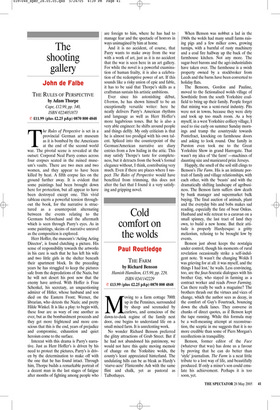The shooting gallery
John de Falbe
THE RULES OF PERSPECTIVE by Adam Thorpe Cape, £12.99, pp. 340, ISBN 0224051873 ✆ £11.99 (plus £2.25 p&p) 0870 800 4848 The Rules of Perspective is set in a provincial German art museum as it is bombed by the Americans at the end of the second world war. The pivotal scene is revealed at the outset: Corporal Neal Parry comes across four corpses seated in the ruined museum’s vaults. There are two men and two women, and they appear to have been killed by heat. A fifth corpse lies on the ground further away. It is evident that some paintings had been brought down here for protection, but all appear to have been destroyed except one. This vivid tableau exerts a powerful tension throughout the book, for the narrative is structured as a counterpoint alternating between the events relating to the Germans beforehand and the aftermath which is seen through Parry’s eyes. As in some paintings, skeins of narrative unravel as the composition is explored.
Herr Hoffer, the museum’s ‘Acting Acting Director’, is found clutching a picture. His sense of responsibility towards the artworks in his care is such that he has left his wife and two little girls in the shelter beneath their apartment block. In the preceding years he has struggled to keep the pictures safe from the depredations of the Nazis, but he will not desert his post now that the enemy have arrived. With Hoffer is Frau Schenkel, his secretary, an unquestioning admirer of Hitler, whose husband and son died on the Eastern Front; Werner, the librarian, who detests the Nazis; and pretty Hilde Winkel. It is like a play: to begin with, these four are as wary of one another as ever, but as the bombardment proceeds and they get more frightened and more conscious that this is the end, years of prejudice and compromise, exhaustion and quiet heroism come to the surface.
Intercut with this drama is Parry’s narrative. Just as Herr Hoffer’s is driven by his need to protect the pictures, Parry’s is driven by the determination to make off with the one that he has found intact. Through him, Thorpe builds a remarkable portrait of a decent man in the last stages of fatigue after months of fighting among people who are foreign to him, where he has had to manage fear and the spectacle of horrors in ways unimagined by him at home.
And it is no accident, of course, that Parry wants to make away from the war with a work of art, just as it is no accident that the war is seen here in an art gallery. For while the novel is a powerful examination of human frailty, it is also a celebration of the redemptive power of art. If this sounds like a risky union of epic and fable, it has to be said that Thorpe’s skills as a craftsman sustain his artistic ambitions.
Ever since his astonishing début, Ulverton, he has shown himself to be an exceptionally versatile writer: here he neatly delivers Parry’s American rhythms and language as well as Herr Hoffer’s more lugubrious tones. But he is also a very able engineer: he shifts around people and things deftly. My only criticism is that he is almost too prodigal with his own talent. Spliced into the counterpoint of the German/American narrative are diary entries from a Jew hiding in the attic. This may satisfy Thorpe’s taste for completeness, but it detracts from the book’s formal elegance without, I think, contributing very much. Even if there are places where I suspect The Rules of Perspective would have benefited from trimming, this does not alter the fact that I found it a very satisfying and gripping novel.






















































 Previous page
Previous page